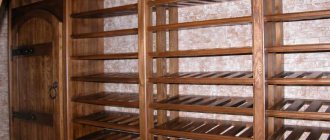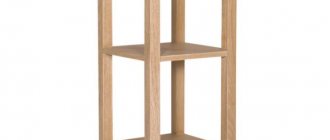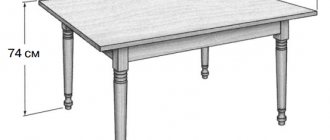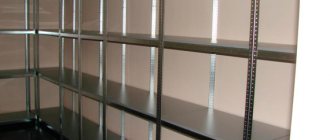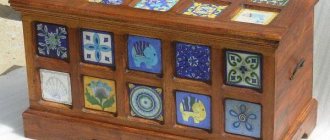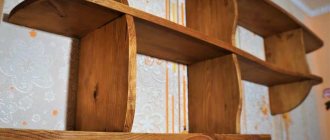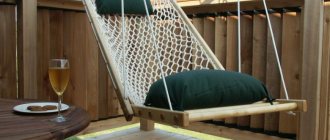Wooden shelving is increasingly being replaced by metal structures. They are used in warehouses, archives, libraries, garages, basements and other premises.
The high strength of the structures allows them to withstand significant loads, the material does not rot, is not susceptible to mold and does not burn. For storing many items and placing them in a certain area, a do-it-yourself profile rack is perfect. The article will tell you how to make it yourself.
Requirements for racks and shelves
Important design characteristics are reliability and functionality. Special requirements apply to the dimensions of the shelves. They should be convenient for storing parts, tools, spare parts and give the garage a well-groomed and lived-in look.
To prevent a chaotic dump, it is advisable to properly organize the space inside the garage. This can be done using a homemade shelving unit. It will allow you to rationally and neatly place things and create comfortable conditions for car care and solving everyday household problems.
When choosing the type of rack you should consider:
- construction material - you should choose one that can be easily cleaned from dirt;
- strength - shelves should not bend easily under weight and be damaged by impacts and scratches;
- sustainability.
Care and operation of a garage made of professional pipes
In order for the built garage to serve for a long time and not lose its attractiveness, the metal profile and cladding must be looked after.
Corrugated sheeting is a “soft” material; it is deformed and becomes dented even from impacts of moderate force. It is necessary to protect the cladding from mechanical stress. Regardless of the type of coating on the walls and roof of the garage, it can be damaged by sharp objects; metal on corrugated sheets will rust in scratched areas. For this reason, scratches and chips of the protective coating must be immediately treated with an anti-corrosion compound. Inside the garage, the walls and ceiling are insulated, and then finished with plastic profiles, OSB boards or plywood.
Sometimes it is necessary to further improve the protection of the garage from noise from the street. But new noise-proofing materials are expensive
It is necessary to pay attention to the doors - they are installed at a level so that they do not close or open on their own (under their own weight)
Garages based on a metal frame made from a profile pipe are very durable. It can be built (if you have plumbing skills) without the involvement of specialists. Before work, you need to decide on the design and the set of necessary parts and structural elements.
Choice
First of all, you need to decide on the material for the structure, the final size, which depends more on the room, and the loads that will be placed on the rack. The set that you will receive in the store depends on all this.
The most interesting thing is that some stores may even offer you to assemble this entire structure after delivery, which again is a nice bonus. Personally, I am sure that, if time allows, it is better to assemble the rack that you chose in the store yourself - time passes, and men simply change toys.
We fasten with bolts or choose welding
So we’ve decided on the material, now let’s move on to choosing a method for assembling the metal components. One of the assembly options is a welding machine. Such structures are a non-demountable structure with high stability.
The second option is to assemble the rack using bolts. It is advisable to make such prefabricated options provided that over time they are planned to be moved to another place, or there is no opportunity (knowledge) to use welding. However, please note that such systems have less rigidity. To strengthen them, they are often fastened to the wall.
Types of shelving designs
The type of design depends on the availability of free space, the purpose of the rack, the material it is made of and the intended method of storage system. Designs can vary both in the method of assembly and in the type of racks.
Stationary shelving system
It is installed in a specific location on a permanent basis. Such designs are designed for heavy objects - they can withstand heavy loads.
Before installation, it is very important to carefully consider the location of the rack and draw diagrams that take into account all the dimensions and area of the garage itself. Such systems are assembled once, usually using brackets.
Mobile mobile racks
Such a system, if necessary, can be moved or transferred to any place without unloading. This is very convenient if you need the tool outdoors. The rack is equipped with special rubberized wheels with a diameter of 10 cm. If desired, they can be fixed, limiting the possibility of movement.
Collapsible models
The shelves of these racks can be mounted to any height using nut or bolt fastening. Among car owners, such designs are considered the most acceptable option. They can be easily disassembled and adjusted at will, changing the height, and also rearranged to any place in the garage.
Hanging or wall shelves
They are attached to the surface of the ceiling or wall anywhere. They allow you to save space and make the most efficient use of free space. A similar structure can be assembled from a corner and hung on special hooks.
Rotating models
This interesting option can be installed in a room where you want to emphasize a certain style. These racks can rotate, providing access to tools and materials from any side. This setup visually resembles a rack of CDs or postcards.
Closed
Such designs protect against the loss of small items and tools and create the appearance of order. They can accommodate both valuable tools and various unsafe materials. In addition, such structures protect stored items from excessive dust.
Closed shelving is made of plastic, metal or wood. Inside they can be divided into cells.
Open
They allow you to quickly access any parts and objects - everything is in plain sight and there is no need to open and close the doors. The structures can be wall-mounted or suspended. To securely fix them, you need to install anchors in advance.
Separate tool cabinets
They can be made in the form of open cells, hooks, magnets or installations with holes. Heavy spare parts and tools cannot be placed on such panels. But they are ideal for storing small items that you need to always have on hand.
Main technical characteristics of shelves for racks
The main components of any rack are: racks, crossbars, shelves, and, if necessary, transverse ties. Tightenings allow you to strengthen the product and are two metal strips that are welded or screwed to the racks.
For the most convenient use of a metal garage rack, during design and installation you must adhere to a number of rules:
- shelves for any type of structure must withstand a certain load and not be deformed;
- the design should be as functional and compact as possible;
- The overall dimensions of the shelves can vary: width - 1.5 - 2 meters, height - 20 - 100 centimeters, depth - 20 - 20 centimeters.
In addition to choosing the main design, you can also play with the type of shelves themselves, the main ones being:
- open. Can be vertical (for wheels), horizontal. When installing such shelves, all your things will be in the public domain;
- closed. Help prevent the loss of things;
- removable. They make it possible to vary the overall dimensions (length and height) of the structure;
- separated. A distinctive feature of a storage system with such shelves is that the shelves are conventionally divided into cells, allowing you to organize and systematize things.
Read also: CNC turret lathe 1v340f30
Which shelves and shelving structures are suitable for the garage ↑
The easiest way to equip your garage with ready-made systems is to choose a stylish option with a simple fastening mechanism. But it’s not always possible to guess with the dimensions of the shelves, and besides, not all purchased options will be as functional and reliable as we would like. It’s more convenient, more profitable and more logical to make a shelf or rack yourself. As a result you will get:
- saving space;
- eliminating clutter;
- convenient storage of tools and other things;
- giving the garage (hangar) a well-groomed, lived-in appearance.
What materials are they made from?
Typically, racks are made of wood or metal, less often - of plastic. The most practical are combined wood-metal structures. The vertical load-bearing supports in them are made of metal, and the horizontal ones are made of wood.
Metal
Metal structures are the most expensive, but at the same time the most reliable, having a long service life. Usually stainless steel is used, less often - aluminum and simple iron. Welded shelves can withstand a lot of weight and look attractive and aesthetically pleasing.
The only disadvantage of such structures is their susceptibility to corrosion. However, it can be easily solved by treating the surface with an anti-corrosion compound.
In addition to welding, metal racks can be connected using bolted joints.
Tree
It is much easier to make a garage rack with your own hands from this material. This is determined by the fact that wood is very easy to process, so you can quickly cut out the necessary elements and adjust them to the required dimensions.
The lack of moisture resistance is a disadvantage of the material, because wood products swell when absorbing moisture. In addition, this material is susceptible to fire, mold and rot, so the structure needs to be treated with special solutions.
Deciding on the design
Scheme of a simple garage shelving
Making your own garage shelving is quite easy. The most important thing is to clearly define your own desires and needs, plan the design and type of construction in advance. Anyone can do such tasks, especially if they have a great desire to do something with their own hands.
Drawing of a rack made of pipes with wooden shelves
The design of the racks has three elements: vertical posts, shelves, crossbars. In some cases, transverse tightening is used. They are not required. They are needed only to increase the rigidity of the frame. To determine the exact design option for the future rack, follow these recommendations.
- The depth and height of the shelves are arbitrary. These parameters are selected only based on the purpose of the niche. Each shelf can be designed to store a specific type of item. It is better to decide all this in advance;
- The distance between the vertical posts must be selected based on the rigidity of the material. For very heavy accessories, the distance should be about 1.5 meters. For long racks, you need to prepare intermediate vertical racks. They will make the system more resilient;
- The lower shelves should be at some distance from the floor. Approximately 50-70 cm. Heavy objects should be stored on them. The optimal height of the remaining shelves will be 37 cm. This is the most rational height, often used in the manufacture of any furniture structure.
Drawing of a metal rack for a garage
It is always easy to decide on design features. Garage owners simply take into account the dimensions and features of the things that will be stored in the structure.
Option for a small garage with a workbench
It is a little more difficult to choose a product design. The garage is intended for practical purposes. However, this does not mean that its interior should be boring and ugly. You can easily create an attractive interior in your garage for little money. In particular, you can decorate the shelving design with regular paint. Today there are paints designed for any material. The color for painting should match the overall color scheme of the room. Colored plastic boxes for storing accessories and tools will become a kind of decoration. They are inexpensive and allow you to create perfect order.
Transparent and multi-colored plastic boxes for garage shelves
Tool shelf - a practical homemade product in the garage
It is practical to install a tool rack in a place near the car, since when servicing you do not have to run through the entire garage in search of this or that key. The ideal location of the shelf is above the roof of the car; the width of the board should be chosen such that a small tool box or the same plane or emery can fit freely.
When constructing a shelf, do not forget about the load on the shelf. Since the instrument is heavy, the design features of the shelf must include metal reinforcements from reinforcement, angle or profiled pipe. Depending on the availability of materials, the thickness of the metal (for reinforcement) should be at least 12 mm. The reinforcement cut into pieces is distributed at a distance of 50 cm from each other (the optimal distance to prevent the board from bending under the influence of metal load). After preparing all the components, we get to work. We distribute the cut reinforcement evenly along the entire length of the future hanging shelf. We select a drill according to the diameter of the pins and drill the wall about 15 cm deep. After drilling, we hammer the reinforcement into the garage wall and align it in length. To fix the shelf you will need a corner. The metal is marked and cut into components that will be welded along the edges of the protruding pins. From the wall under the board, a strip of metal is welded and cut along the length of the shelf, holes are drilled in it to fix the board. The last thing is to lay the boards cut to size and fix them with screws or bolts. Having completed all the repair work, the finished tool shelf can be painted in the desired color.
Garage furniture is not difficult to make. And if a person likes to make things with his own hands, then it will also be interesting. Do you have a lot of tools left, but no more space on the shelf? Then you can think about building a garage shelving unit. At first glance, it seems bulky and heavy in design. But don’t be upset, since it’s all just a mountain of metal, bolted to wooden elements, that is, you can do everything yourself.
Recommendations for the manufacture of equipment for the production of bent profile pipes
There are many ways to bend pipes. One of the simplest is to use two tooling pipes with a larger internal diameter and a longer length than the workpiece. The first pipe of the equipment is rigidly fixed on a workbench or on any plane; an option is driven vertically into the ground. The workpiece is bent by fixing the bending point of the profile pipe in the first pipe of the equipment with a wooden wedge. Using the second pipe of the equipment, put on the remaining part of the profile, using it as a shoulder, we bend the profile to the desired degree. This bending occurs at one point.
A rocking chair with forged elements looks quite aesthetically pleasing.
In the case where the bend has a complex configuration, the equipment becomes more complicated. The easiest option is to take a 200x50 mm board, the length will be determined by the workpiece, and mark the reference points of the profile bend on it. Secure the board to a workbench, floor or other hard surface. Then, in the designated places, bolt the semicircular wooden stops around which the pipe bends.
The shape of the stops determines the desired bend of the workpiece.
The pipe is fixed in three stops, and then using a larger diameter pipe we bend the workpiece in the stops that define the bends.
In this simple way, parts of a metal chair or a headboard from a profile pipe are bent.
Construction layout and drawings
First of all, you need to determine what exactly will be stored in the garage, and then make a preliminary drawing with all the dimensions. The next step is to find a place to install it. To do this, the room must be divided into functional zones.
At the entrance to the garage, you need to store what you may need every day, and place in the far corner what is rarely needed.
Finally, you can draw up a final drawing indicating the location of tools, parts, liquids, oils and other necessary things.
Making a product design
Experienced car enthusiasts recommend using one of the garage walls for shelving. You choose the height and length of the product yourself, but as a rule, shelves are made from the floor to the ceiling. At the bottom, the height of the shelves is greater than the rest, since this is where the largest items are stored. You can make the upper shelves at a minimum height; small items are often stored there.
Please note that a gap of about 30 - 50 centimeters must be left from the bottom shelf to the floor. This will allow you to clean under the shelves properly. In addition, leave a distance from the side walls to the rack posts of about 10-20 centimeters, this will make it easier for you to carry out installation.
What tools and materials are needed?
In order to install a rack quickly and efficiently, you need to stock up on all the necessary tools and materials so that in the future you will not be distracted by searching for what is missing.
To make tool shelves in the garage with your own hands, you may need:
- Chipboard (chipboard) or plywood board up to two centimeters thick;
- fastening anchors;
- shelf material;
- brackets for fixing the product on the wall;
- drill;
- electric jigsaw;
- building level;
- perforator with nozzle;
- tape measure;
- hooks for fastening;
- set of self-tapping screws.
Self-assembly
If you want a homemade option, then it’s worth learning how to make a shelving unit from corners with your own hands, since this is one of the easiest ways to make such a structure yourself.
No special skills or craftsmanship are required for this. Usually, racks are assembled from scrap materials, or simply from inexpensive parts, such as simple corners and profiles.
They are used to make the basis of the structure - a frame, on which shelves are then laid, most often wooden or made of plywood and chipboard. In addition, if available, remnants of pipes that are suitable in size are well suited for the frame.
Which profile pipes are suitable and how many of them will be needed
It all depends on the size and shape of the rack. It is better to use rectangular profile pipes. First, I choose a diagram and drawing of the future shelving so that it fits the room in height and size. Next, you need to decide whether all structural elements will be the same or not. It is better to weld the racks and crossbars from pipes of the same section, but the longitudinal strips are thinner.
Having chosen the desired scheme, I write down all the dimensions of the planks and height posts, their number. Then I calculate the total length of all pipes of each standard size. This will help you buy profile rolled products so that as little scraps as possible remain.
When making the first rack, you will need 21.6 m of 20x40 mm profile pipe. When using rolled products 1.8 m long, 12 pipes will be needed. With a pipe length of 2.7 m, 8 pipes will be needed.
For the second option, depending on the size of the walls, you will need to measure and calculate all pipe lengths. For racks you can use larger profile pipes. Knowing the dimensions of the wall and choosing the distance between the shelves, these dimensions are entered into the template, and then the number of pipes used is calculated depending on the options available for sale.
If the store has pipes of 6, 8, 12 m, then for ease of transportation they can be cut to the required length, so make calculations in advance using the proposed template.
How to make a metal shelving unit with wooden shelves
A metal structure for a garage is an ideal option. Although it is more expensive, it has high strength, immunity to mold, moisture, mildew, fire resistance and a long service life. To reduce the cost of the rack, the shelves can be made of wood.
It is best to make the racks from rectangular pipes with a side width of no more than five centimeters, and use a metal corner for the crossbars. It can be welded to the vertical guides or screwed with bolts, then it will be possible to change the height of the shelves.
Step-by-step assembly of a garage shelving system:
- The prepared components must be cut using a grinder in accordance with the required dimensions.
- Mark the location of the shelves on the racks.
- Weld or bolt the corners to the posts, keeping them horizontal.
- Coat the metal frame with an anti-corrosion compound.
- Cut shelves from wooden boards and fit them to the frame.
- Sand the finished shelves, paint them and attach them to the metal frame using self-tapping screws, fitting them close to each other.
Do-it-yourself shelving in the garage: preparation before production
So, you've decided to make your own garage shelving. Before you begin making shelves from any material, you must carry out the necessary preparation for this.
Preparatory stage. Taking measurements and making a drawing.
First of all, decide on the size of the structure and then take all the necessary measurements.
- start by measuring the height and width of your future shelving;
- then consider the required number of shelves and their height;
- decide on the material of the shelves;
- Draw on paper the desired appearance of the finished structure. Having a drawing in front of your eyes will make it easier for you to make a shelving unit.
How to make shelving in the garage with your own hands - photo drawings:
How to make shelving in the garage: metal and wood?
You have decided to make a shelving unit out of steel and have already drawn up a drawing. Now let's move on to the next stage .
Stage 2. Purchase of materials.
Make a list of the quantity of materials you need and their sizes, then feel free to go to any hardware store. To make the frame you will need a steel channel and corners. If you want to make a completely steel structure, then buy the required number of sheets of metal. If your plans are to make wooden shelves on a metal frame, then you will need blocks of wood, plywood or chipboard.
Stage 3. Preparing tools.
To make shelves you need the following tools and equipment:
- electric drill;
- angle grinder (grinder);
- screwdriver;
- if you want to weld rack parts, you will need a welding machine and electrodes;
- hacksaw;
- hammer;
- bubble or laser level;
- screws, bolts, nails, dowels;
- construction tape;
- pencil.
Stage 4. Metal cutting process.
In accordance with the dimensions and drawing, we carefully and slowly cut the metal vertical (supports and sections) and horizontal (shelves) parts of the rack.
Stage 5. Assembly of the structure.
First we secure and install the frame. For greater reliability, you can attach it to the wall and ceiling using dowels or special screws.
After installing the vertical racks, proceed to attaching the shelves. You can bolt them on or weld them to the frame. Don't forget to use a level when doing this.
Stage 6. Painting.
To prevent the rack from becoming rusty over time, it must be primed and coated with special anti-corrosion paint.
If you want to make wooden shelving for your garage for storage and already have a ready-made drawing , then you can move on to the next stage.
Stage 2. Purchase of materials.
The most common wood garage shelving materials are oak and pine . Vertical and transverse racks are made from timber of different sizes, and for shelves you can buy boards, sheets of plywood or chipboard.
Important! Consider the wood carefully before purchasing. It should be dry and without visible defects.
Stage 3. Necessary tools and construction equipment:
- electric tools: drill, grinder, screwdriver;
- wood hacksaw;
- hammer;
- tape measure and pencil;
- level;
- nails, screws, self-tapping screws, bolts.
Stage 4. Cutting wooden parts. Adhering to the required dimensions and drawing, we cut all the wooden supports and racks, and then the shelves. We treat all parts with a special antiseptic intended for wood.
Stage 5. Assembly of the structure.
First, we assemble and secure the entire frame, after which we attach the shelves to it using metal corners and M5 bolts. We check the strength of the finished structure and once again measure the evenness of all surfaces and corners with a level.
Stage 6. We carefully and without haste paint the structure to prevent it from rotting and the formation of mold on it. We wait for it to dry completely, and then install it in the chosen place. That's it, your rack is ready!
How to make a garage rack with your own hands from a profile:
So, now you know how to make wooden or metal garage shelving with your own hands. At first glance, this is a rather complex process with many nuances .
Wood shelf
Wood is more environmentally friendly and economical compared to metal
The most common solution for arranging a garage is the installation of wooden shelves. The choice of this option is due to the availability and low price of wood: bars and boards. In order for the structure to be aesthetically attractive and safe to use, all its elements are pre-treated: leveled, sanded, coated with a fire-retardant composition.
Design + drawing
Drawing of a wooden shelf
Designing a shelf made of wood is no different from a similar process in the manufacture of metal structures. The dimensions of the parts are chosen at your discretion. The most convenient are shelves whose length corresponds to the distance of an outstretched arm. The height can be any, up to the ceiling. The easiest way to design and manufacture a permanent wall structure. It is installed in a corner or on a plane.
Required tools and materials
Before starting work, the tree must be planed
To work with wood you will need:
- drill or screwdriver;
- drill;
- hacksaw or jigsaw;
- sander;
- bubble level;
- construction square;
- ruler and tape measure;
- simple pencil.
Materials for making a simple wall shelf 110 cm long, 30 cm high and 25 cm deep (width):
- planed boards 16 mm thick;
- wood screws;
- dowels for fastening to the wall;
- brackets
- fire-retardant composition.
Manufacturing instructions
Surface preparation in full swing
Step 1. Using a jigsaw or hacksaw, prepare two blades for the side walls. Between them there will be two horizontal shelves. The distance between them is equal to the height of the end ones.
Step 2. Prepare canvas for horizontal shelves.
Step 3. Process the parts with a grinder.
Step 4. Cover the workpieces with a fire-retardant composition and allow drying time recommended by the manufacturer.
Step 5. Start assembling the structure and lay the bottom sheet on a flat horizontal surface. Take a ruler and a simple pencil, measure 8 mm on the right and left, draw two parallel lines.
Step 6. On each line from above and below towards the middle of the canvas, measure 5 mm and put marks.
Step 7. Drill 4 holes at the found points.
Step 8. In a similar way, mark the surface of the top shelf and drill 4 holes in it.
Step 9. Install the left end shelf on the bottom shelf. Connect the parts with self-tapping screws.
Step 10. The right end board is attached in a similar way.
Step 11. Place the top shelf on the resulting structure and attach it through the previously drilled holes.
Step 12. Brackets are attached to the upper part of the back surface of the end boards.
Step 13. Try the shelf against the wall, make markings for the dowels.
Step 14. Drill holes in the wall.
Step 15. Screw in the dowels.
Step 16. Hang the shelf.
Based on the proposed step-by-step instructions, you can make a structure from several shelves, strengthening it with vertically installed bars with a section of 40x50 mm or 50x50 mm. In order to give the shelf stability, it is attached to the wall with anchors or dowels.
Making hanging shelves
They can be made from a metal corner. The base can be made of wood, and the side walls will be a special cable or a profile square pipe. Such shelves are hung on hooks driven into the ceiling beams and, if necessary, can be quickly dismantled.
The downside is that they are quite wobbly and can wobble. It is not recommended to store expensive tools and fragile items on such shelves.
To eliminate the instability of the structure, the hanging shelf is mounted on studs.
Stages of manufacturing hanging shelves:
- Cut shelves to the desired size from a sheet of MDF (medium density fiberboard) or plywood. The recommended distance between the supporting studs is 60-70 centimeters.
- To increase strength, the ends of the slabs can be edged with a metal profile.
- Mark holes for pins along the edges of the shelf. It is advisable to drill no closer than five centimeters from the edges of the slab.
- Then the shelf is applied to the ceiling, and the places for fastening are marked on it using a pencil. Holes for anchors are drilled in the ceiling according to the marks, then the fasteners are driven into the concrete and tightened with nuts.
- Long studs need to be connected to anchors that are placed on the ceiling and secured with nuts.
- Once all the studs are secured to the ceiling, you can install the shelves. You need to screw a nut, a washer, and then a shelf onto the stud. Then secure it with a washer and nut. The final adjustment is made by level.
A hanging shelf can significantly save space in your garage.
Preliminary preparation
You should start by preparing a drawing. You can do it yourself, using, for example, frames offered for sale as a basis. It is necessary to calculate the overall dimensions of the shelves and the parameters of the base for them.
Moreover, their dimensions should be based on preliminary measurements of the space in the garage. If you take these measurements correctly, you can consider that half the job is already done.
Shelf drawing
- At the same stage, it is necessary to think about how the shelves will be connected to the frame, and the frame itself will be further strengthened by attaching it to the walls or floor.
- An important parameter here will be the height, since, in the case of low ceilings, it is advisable to make the frame height up to the ceiling, leaving no free space.
- Determining the distance between shelves is one of the important design points, since it is this that determines the rationality of distributing things across levels.
- Traditionally, the lower ones are made the most spacious: large and heavy equipment is placed on them; in addition, they are often used to store wheels and rims.
- Usually the following rule is used - the higher the shelf, the less weight should be placed on it and, accordingly, its height is lower. This can be explained quite simply – by increasing the stability of the rack as a whole.
- We should also talk about the depth of the shelving. Shelves that are too narrow make the entire rack impractical, and shelves that are too deep make it much more difficult to access. The optimal depth is 50-60 cm.
- The width is usually determined by the tensile strength of the material from which the shelves are made. There is no need to make the rack too heavy by making shelves more than 1.5 m wide (this will require too thick iron or wood so that they do not sag under the weight). Usually the width is about 90-150 cm.
Let's look at the most popular shelving devices that you can make yourself.
How to make and decorate beautiful garden beds with your own hands: simple, tall, smart. For flowers and vegetables. Original ideas (80+ Photos & Videos)
Useful tips for organizing your garage space
Since the garage, by its intended purpose, is a home for cars, you should be careful to ensure that the space for tools is well organized. Also, there will probably be several square meters in the room in order to remove some of the items from the apartment, so as not to clutter the living space.
When installing various devices indoors, it is important to consider that all available equipment is at hand. To do this, you can use the following recommendations:
- Regardless of the size of the garage, it is important to have a rack with shelves on which you can put tools, materials and useful items.
- If you want to carry out routine car repairs with your own hands or perform other repair work, then you definitely need to make a workbench in the garage.
- To overhaul a car, you should make your own cellar - it will not only allow you to regularly inspect the mechanism, but also provide additional storage space.
- Finally, it is quite possible for a garage to set up its own small workshop, the accessories for which can also be made with your own hands.
Rational organization of space in the garage creates many tangible advantages:
- it becomes possible to independently carry out short-term repairs of car parts and other mechanisms, due to which you can significantly save money;
- Convenient placement of tools significantly speeds up work and saves time;
- creating additional places for storing tools, old things, clothes makes it possible to relieve the apartment of things that are rarely used in the household;
- Finally, thoughtful internal logistics of the premises allow it to maintain its attractive appearance and avoid clutter.
NOTE. At the project development stage, it is important to take into account the area of the room, and also take into account several mandatory utility compartments - for storing summer and winter tires, cans, jacks, etc.
Video TOP best ideas for decorating a garage with your own hands
Layout, diagrams, drawings, ideas
In the garage you need not only a rack, but also a workbench and a stand for hand tools - all kinds of keys and other small things, of which there are a lot and it is difficult to come up with a specific convenient storage place.
The workbench can be made in the center of the rack. This is convenient - everything you need will be at hand, you won’t have to constantly go to the shelves.
Garage shelving with workbench is convenient
The workbench can be part of the system, or you can make two separate modules, between which you can install the required table. If you don’t like this arrangement, you can change the configuration - at least put it at an angle.
As for the tool stand. There is a factory option - a perforated sheet of metal with holders hung on it. The idea is very good except for the price.
Comfortable))
As usual, there are also several homemade projects (what would a garage be without them) on the same topic. The ideas are simple to implement, maybe not so elegant, but convenient:
- On boards, chipboard sheets, plywood, place nails under each tool. To avoid confusion about where to hang something, trace the instrument in place and paint it with some color.
Everything is in order and in its place
- For heavier equipment - large keys, etc. You can use a mesh onto which you weld hooks from wire. Nail the mesh to the wall.
Option for heavier and bulkier tools
- Make a bar with holes cut in it into which tools are lowered.
This tool stand is very easy to make with your own hands.
And if desired, all this can be put on wheels - to make the tool stand mobile. This is the case if during the warm season you prefer to work with the machine outside.
You can easily roll back to where you want
Well, for inspiration... so that all the tools are in place))
Full order))
The nuances of assembling metal shelves
This process has its own characteristics. There are mainly two methods used to assemble shelves: welding and bolting.
In both cases, parallelism is required at the preparatory stage, because the welded flange cannot be corrected without destruction. It is also undesirable to redo the bolted connection, as this may lead to a loss of aesthetic appearance.
Before welding or drilling holes for bolted connections, the shelf must be secured to the vertical posts using clamps and the horizontalness must be checked using a building level in the longitudinal and transverse directions. After this, the shelf is attached to the vertical posts by welding, the clamps are removed and the horizontality is checked again. If everything is normal, then final welding is performed.
With a bolted connection, two holes are drilled on one side, and this side is secured with the help of bolts, and the clamps are removed. They remain on the other side. Then the horizontalness is checked and, if necessary, correction is made. After this, two more holes are drilled and secured with a bolted connection.
Useful tips
Before planning garage shelves, you need to determine how they will be attached. Bolted technology is usually used for wooden structures, welded - for metal ones. Both technologies allow structures to serve properly for a long time. However, they have some disadvantages.
Welded shelves cannot be disassembled. If you change the layout of the garage, simply dismantling the welded product will not work. The main positive factor of this design is its reliability - welding seams are not at all easy to destroy.
Bolted racks cannot provide sufficient rigidity. For stability, the structure must be additionally attached to the wall. However, it has a significant positive factor - mobility. The shelves are easy to disassemble and assemble, and you can also make different distances between them.
garagehow to make it yourself shelving shelving in the garage
General design issues
Rack with shelves
First of all, you should forget about the first ideas that come to mind - creating the simplest hanging shelves, with a load or area that can accommodate all the property currently contained in the garage. Firstly, this is not rational from the point of view of their manufacture, and secondly, over time, the volume of things stored in the garage increases, so new and new designs will have to be made.
Therefore, it is immediately necessary to plan the design of the shelves in such a way that it is:
- universal
- expandable
- as easily movable as possible
That is, it is advisable not to make each shelf separately, but to make an entire rack consisting of several shelves as a single structure.
Rack with cabinet
The next important question is what the design of the rack will be - collapsible or not. Typically, non-removable structures are more durable and can withstand heavy loads, however, their disadvantages include difficulties in expansion, dismantling and transportation.
Collapsible structures are less stable, their rigidity is far from that of non-collapsible ones. Often, for additional stability, such structures have to be attached to walls. However, they have two special advantages - easy expandability and mobility. In addition, thanks to their modularity, shelving can be made in a variety of sizes.
In this case, the choice depends solely on the desires of each person.
